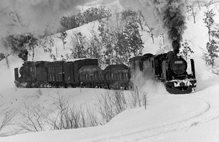Japanese Steam Locomotives
A Modern Perspective
The Final 28 Active Classes

During the first 105 years of Japanese steam engines,
the Japanese government had a total of 374 models comprised of the following
: 196 Tank model engines, 130 Tender model engines and 48 Narrow Gauge engines.
The Class names first letter indicates the number of powered axles. For example: Type "B" to four driving wheels (a side has two driving wheels), type "C" has six powered axles and type "D" has eight. The next two numerals, 10 to 49 refer to "Tank Engines", 50 to 99 refer to "Tender Engines". The last numerals refer to each class engines individual assigned number. Six tank type engines, and twenty tender type engines, for a total of twenty-six engines, with alphabetically named models went into production, or remodeling, after 1928. Before 1928, manufactured engines were assigned different model names. The rule that was followed for each model name and manufactured number of engines, was that both were used, as well as numerals, to more clearly identify a particular engine.
For example, class ....... 8500, 8550, 8600, 8620, 8700, 8800 ......... And manufacturing numbers added to each model number. For example, class 8700, order by manufacturing -> 8700 8701 8702 8703 8704 ........ If the number ran up to the next model name, then one number was added. For example, class 8620 & 8620 8621..... 8698 8699 18620 18621 ..... 18699 28620 28621 .... Therefore, it's not always true that numbers equaled production volume. And the thousands digit in a model name had the following meaning ; 1-999 (No.1000-1168 were included after 1924) .... Four driving wheel tank engine. 1000-3999 .... Six driving wheel tank engine. (3900-3999 .... Rack Track engine) 4000-4999 .... Eight or more driving wheel tank engine. (4500-4999 ... Articulated, Duplex engine) 5000-6999 .... Four driving wheel tender engine. 7000-8999 .....Six driving wheel tender engine. 9000-9999 .... Eight or more driving wheel tender engine. This complicated numbering system in regard to numbering and models became bogged down and cumbersome and an alphabetical system followed. However, models appearing before 1928, were not changed, as well as, those models after 1928 procured from private railroads. Previous to 1928 and shortly thereafter a few models underwent name changes from the old to the new. For example : 18900 became C51 and 9900 became D50. Of these twenty-six alphabetically named models above, seventeen classes survived during the last ten years. However,two engines bear no letter of the alphabet...they were class 8620 and 9600...until the last year of steam. Thus, in the last ten year period, nineteen models survived. I constructed this Japanese steam engine webpage to be as understandable, as much as possible, for the general site-visitor. Therefore I attach great importance to history ..... for example, year, engine biographical data, history of operation or service area ... etc, than technical data. There are already many books and the other websites with Japanese steam locomotive technical information. So, please consult other websites ......... Details of 28 models are now described. |
Jump Start Index (Blue color models disappeared before during steams final 10 years)
| Configuration | US Type | Class Name
| 0-4-0 Tank |
|
B20
| 4-4-2 Tank |
|
B10
| 2-6-2 Tank |
|
C12
| 2-6-4 Tank |
|
C10
C11
| 2-10-4 Tank |
|
E10
| 4-4-0 Tender | American
|
B50
| 2-6-0 Tender | Mogul
|
8620
C50
C56
| 2-6-2 Tender | Prairie
|
C58
| 4-6-2 Tender | Pacific
|
C51
C52
C53
C54
C55
C57
C59
| 4-6-4 Tender | Hudson
|
C60
C61
C62
| 2-8-0 Tender | Consolidation
|
9600
| 2-8-2 Tender | Mikado
|
D50
D51
D52
| 2-8-4 Tender | Berkshire
|
D60
D61
D62
| |


